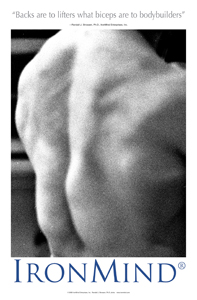…train your back(side).
The famous IronMind poster is more than just an end-goal. It signifies the process of successful lifting. The back can collectively start at the upper traps which flow down into the spine of the scapula (the sideways ridge on your shoulder blade). The middle and lower traps (attaching all the way down to the last thoracic vertebrae) flow up and attach along that same position as well. Then, the rhomboids hold the medial (inside) border of the scapulae to the spine. The rear deltoids could be considered part of the back as well, and they attach along the spine of the scapula over the important external shoulder rotators (which are primarily located along different aspects of the scapula). However, it’s the middle/lower traps, lats (which attach anywhere from the iliac crest — rear hip area — to the mid thoracic area and funnel into an insertion on the medial aspect of the proximal humerus, or upper arm bone), and erector spinae muscles (i.e. spinal erectors) that attach along the vertebral column.
What It All Does
That collection of musculature has the primary of function of holding the trunk in proper alignment and posture during lifting. The upper back muscles maintain good thoracic extension during squatting, pressing, and deadlifting and they hold the scapulae together and maintain shoulder position on the bench. The lower back muscles hold the pelvis in place to allow for a stretch on the hamstrings during squats (specifically the low bar variation), deadlifts, RDLs, rack pulls, and other pulling movements. The back and hamstrings are so finely integrated that many movements train both at the same time. However, this area of the body is largely neglected because it can’t be seen easily in the mirror.
Training Inclusion
Most training sessions, especially for less experienced lifters, should include a squat, a press, and a pulling movement. If you are worry about your back and hamstring strength or development, then it’s already too late. This should be the proudest area of your body as it will set you apart from others, balance your physique, and so effectively contribute to your lifting that most of everything else will improve along with the front of your physique. If you don’t currently include RDLs or a horizontal rowing movement, sprinkle them in your training week (this advice applies to any general strength trainee as well as powerlifters that aren’t tapering for a meet).
Other Indicators of Back/Hamstring Weakness
Some glaring indicators of requiring improved strength and musculature in the back and hamstrings include, but are not limited to dropping the chest in any movement, the torso tipping forward out of the bottom of a squat or at the start of a deadlift, a weak second pull in the Olympic lifts, and the knees scooping forward under the bar on heavy deadlift lockouts. While you may be able to get by with these inefficient mechanics, sooner or later you will reach a point that is too limited by your lack of back or hamstring strength that it must be addressed before progress can continue.
Short on time?
Lastly, if you are ever limited in your training time then make an effort to train your back, even if you neglect squatting. The back and hamstrings sometimes are so limiting for some trainees that accumulated work is necessary over time to develop them to improve the foundation lifts (squat, press, bench, and deadlift). Using RDLs as opposed to squats or deadlifts will be a good substitute when feeling overtrained, coming back from sickness, or easing back into training after a rough travel or work schedule. Furthermore, by getting the upper back musculature stronger and thicker, all upper body movements are reinforced and subsequently strengthened.
Making the upper back and hamstrings strong doesn’t have to be a soul draining experience. Lifts that improve these areas are easy to add into existing programs and might even need to maintain priority on those constrained training sessions. Rest assured, if you’re already doubting the strength or size of your backside, then you’re already in a deficiency — but it’s never too late to start.
Here are some more videos from the Australia trip that have nothing to do with building an impressive back.
[spoiler show=”Show The Vids” hide=”Hide The Vids”]
[/spoiler]

